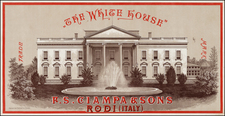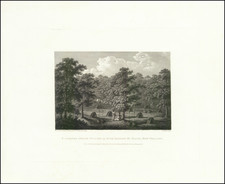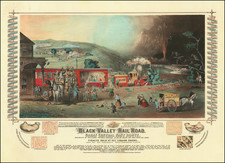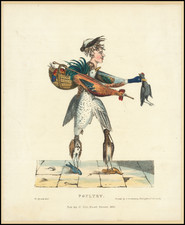Abraham Ortelius Requests Assistance in Tracking Down Books and Maps for his Studies.
Ortelius Lists His Friends All Over Europe.
This autograph letter, written by Abraham Ortelius, creator of the first modern atlas, to his nephew Jacobus Colius on April 3, 1597, offers a revealing glimpse into Ortelius's ongoing work on the Theatrum, his expansive social circle, and his deep relationship with Colius, who was akin to an adopted son to him. In it, Ortelius expresses support for his nephew's proposed travels through France, Germany, and Italy, highlighting the professional and scholarly value such a journey holds.
The letter vividly reflects Ortelius's unwavering dedication to enriching his magnum opus, the Theatrum Orbis Terrarum. He explicitly directs Colius to document his travels meticulously and to acquire materials such as books, maps, and coins, with a particular emphasis on those featuring place names. These instructions underscore Ortelius's commitment to continually augmenting the Theatrum with new knowledge and discoveries. This steadfast dedication is palpable throughout the correspondence and underscores Ortelius's lifelong devotion to his work, a devotion that persisted unabated until his death, just over a year after this letter was written.
Furthermore, the letter serves as a testament to Ortelius's extensive network, linking scholars, mathematicians, and geographers across Europe, from Paris to Naples. This tapestry of connections illustrates Ortelius's reach and the crucial role of personal and scholarly networks in the exchange of knowledge during this period. The array of European intellectuals and acquaintances mentioned (listed below) sheds light on Ortelius's active participation in a broader intellectual community.
The letter also delves into the political and economic fabric of the era, notably through the reference to Lemensio (Henricke van Lemens, a close associate and eventual heir to Ortelius) and his financial support to a Cardinal amidst challenging times.
The correspondence concludes with a heartfelt personal note. Ortelius expresses a strong desire for familial closeness and support, inviting Colius to return to Antwerp and promising him riches should he choose to do so. However, Colius would eventually chart a different course, opting to return to London instead, a decision that perhaps speaks volumes about his own aspirations.
Overall, this rich letter offers insights into Ortelius's practices of knowledge gathering, the importance of network-building in the intellectual community of late-16th-century Europe, and the personal connections that underpinned scholarly work during the Renaissance.
Translation
Greetings, my nephew. Are you intending to travel through France, Germany, and Italy? I commend this and wish you a successful journey there and back. I hope you will describe your trip to me in writing. If you come across anything related to our field of study during your travels, whether it be books, maps, or coins, especially those containing place names, please purchase them for me with my money, and you will do me a great favor. In Bologna, there's a professor of mathematics named Maginus [Giovanni Antonio Magini, 1555–1617] who has promised many geographical maps; he has already given me one that I have, of the Bolognese territory. If he gives anything more, please ensure it reaches me.
You wish to have letters for my friends. However, as I am uncertain whether you will travel through France or Germany, I am unsure whom to recommend. Also, I am doubtful whether you will have left before these letters reach you; if they do reach you, I suggest you return by a different route than you went. If you go through Germany, return via France, and vice versa. In Paris, I have friends whom I greet: Petrus Pithoeus [Pierre Pithou, 1539–1596], Adamus Plancium [Adam de la Planche]. In Metz, Johannem Jacobum Boissartum [Jean-Jacques Boissard, 1528–1602]. In Germany, Camerarius in Nuremberg; Nathan Chytreus [Nathan Chyträus, 1543–1598] in Bremen; Marcus Velserus [Mark Welser, 1558–1614] in Augsburg, Adolphus Occo [Adolf Occo, 1524–1606]; and in Munich, Bavaria, Johannem Georgium à Werdenstein [Johann Georg von Werdenstein, 1542–1608], among many others. In Rome, you will find my good Belgian friend Johannes Macarius [Jean Macarius, 1551–1617], also known as L'heureux. In Venice, I might have a great friend, Franciscus Superantius (commonly known as de la Soranzo) [Francesco Soranzo, 1557-1607], though I am not certain; however, I have often felt his kindness. It's been a long time since I received any letters from him; whether they were lost on the way or he has been too busy, I don't know. In Naples, please greet Vincentius de la Porta [Giambattista della Porta, 1535? - 4 February 1615] for me.
You won't have Scolierus [Hieronymus or Jérôme Scholier or Scholiers or Schollier or Scolerius, 1553-?] as a companion, as he seems inclined to stay with us here. He sends his regards. From the same source, I understand that Lemensio [Henricke van Lemens] has not suffered any loss due to our king's protests. However, the same Lemensio has lent a considerable sum of money to our Cardinal during these trying times, as have many others among us. I have nothing more to add, except this: when you return home from your travels, please make your way back to Antwerp. I greatly desire to live together and be of mutual assistance. I promise, as far as I am concerned, riches, and these riches are from me. Farewell. Antwerp, April 3, 1597.
Transcription
S. P. An ne nepos? Galliam, Germaniam, Italiam lustrare animus? laudo. et itum reditumque faustum voveo speróque. Si me audiveris hoc iter tuum calamo describes. In itinere si quid nostri studij offenderis, sive librorum, tabularum, sive num- morum; imprimis que locorum nomina continent, mea pecunia mihi redimes et gratum facies. Bononię quidam matheseos pro- fessor cognomine Maginus promittit multas tabulas geographicas, unam dedit quam habeo, agri nempe Bononiensis. Si quid pre- terea dederit, fac ad me veniat, obsecro. Cupis litteras ad amicos meos. at quia incertus sum quam viam institues aut Gallicam aut Germanicam, dubius sum ad quos. dubius item discesseris priusquam has¹ ad te pervenerint; si autem pervenerint, auctor tibi sim, ut alia via eas quam redeas. Si eas Germaniam, per Galliam redeas. et contra. Parisijs habeo amicos quos saluto Petrum Pithoeum, Adamum Plancium. Metis Johannem Jacobum Boissartum. In Germania Camerarium Nurenbergę: Bremę Na- thanem Chytreum: Auguste Marcum Velserum, Adolphum Oc- conem; Monachi in Bavaria Johannem Georgium à Werdenstein. Atque hos inter multos. Rome adibis familiarem meum amicum Belgam Johannem Macarium alias L'heureux. Venetijs magnum inter ceteros amicum Franciscum Superantium (vulgo de la Soranzo) habeam subdubito, at habuisse me sepius sensi suis beneficijs. Iamdiu autem nihil litterarum ab eo habui, an in via perierint, an ille ad multos abierit, ignoro. Neapoli Vincentium de la Porta à me salutabis. Scolierum comitem non habebis, manere enim apud nos illi animum esse video. idem te salutat. ex eodem cognosce nihil damni Lemensio accidisse ex regis nostri protestibus. Tamen eundem nostro Cardinali in his suis angustijs summam pecuniarum credidisse. Idem fecere multi alij ex nostris. Quod his addam non habeo. Hoc autem addo, nempe, Cum domum ex hac tua peregrinatione redieris, domum iterum Antverpiam te facere, valde me desiderare, ut unà vivere liceat, mutuaque opera uti. Promitto, quod ad me, divitias, easque à me. His vale. Antverpię III. Aprilis. 1597.
Abrah. Ortelius.
Clarissimo V. Domino Jacobo Colio
Orteliano, nepoti suo carissimo.
Lugdunum.
People Described
We borrow heavily from Marcel Van Den Broecke's work on Ortelius's sources, with sections in quotes taken from his website.
-
"Colius or Cools, Jacobus junior or Ortelianus or Carbonius, Antwerp 1563 - London 1628, was a nephew of Ortelius, but in fact almost an adopted son, who lived most of his life in London and who inherited many of Ortelius’ personal possessions, although (most of) Ortelius library was auctioned in Antwerp in September 1598. Many letters were exchanged between these two; Ortelius tried to convince him to come to Antwerp and settle in his house, promising him a fortune [this letter], but Jacob declined."
-
"Magini, Giovanni Antonio, 1555 – 1617, studied medicine, mathematics, astronomy and philosophy in Bologna. He published “Ephemerides” tables, and books on astronomy and astrology. He also drew a map of Bologna published in Bologna, 1595, mentioned in Hessels (303) as being in Ortelius’ possession, further of Urbino, Bologna, 1596, Liguria, Bologna, 1597, Romagna, Bologna, 1597, Parma & Piacentia, Bologna, 1598 used by Ortelius/Vrients (Ort124a,135,126,134,132). Magini and his map of Bologna are mentioned in the “Catalogus Auctorum” of the “Theatrum” of 1601."
-
"Pithœus, Petrus or Pierre Pithou,1539 – 1596, “the learned” was a French philologist and advocate who wrote “Adversaria”, mentioned twice as a source in Ortelius’ “Synonymia” (1578) quoting Marcellinus’ “History” (Ort196), twice in “Thesaurus” (1587) and 5 times in “Thesaurus” (1596). Pithœus also wrote a “Journal” (Ort232), and also “Historia Miscella” which Ortelius refers to 115 times as a source in his “Thesaurus” (1587) and 180 times in “Thesaurus” (1596), mostly without mentioning its author. In lemma ZENOPHRVRIVM of “Thesaurus” (1596), Ortelius refers to a copy of Pithœus’ “Histria Miscella” bound together with Nicephorus’ “Chronologia”. Pithœus also wrote “Historiæ Francorum” of which Ortelius bought a copy from Plantin in 1595. In lemma TOLOSA of Ortelius’ “Thesaurus” (1587) Pithœus’ “Quintilianum” is mentioned as a source. In lemma EBVRONES of “Thesaurus” (1596) Ortelius refers to the biography of Charles the Great, edited by Pithœus, He is mentioned as a source in the “Catalogus Auctorum” of Ortelius’ “Synonymia” (1578), and 5 times in its text. In “Thesaurus” (1587) Pithœus is mentioned 127 times as a source. In lemma SIDOLEVCVM of “Thesaurus” (1596) Pithoeus quotes from Antoninus’ “Itinerarium”. In lemma VALEPONGA of “Thesaurus” (1596) Ortelius refers to Pithoeus as the editor of “Vita Ludovici Pii Imp.” In “Thesaurus” (1596), Pithœus is a;together mentioned 145 times as a source. Sweertius in his “Lacrymae” calls Pithoeus a close French friend of Ortelius."
-
"De la Planche, Adam, fl. late 16th century,of Paris corresponded with Ortelius in 1595 about his gift to Ortelius, viz. the Isle de France map (Hessels nr. 279) and he contributed to Ortelius’ “Album Amicorum” (f. 110 v)."
See, Fontes Cartographici Orteliani, page 161: "In 1595, Adam de la Planche wrote to Ortelius that he had received a hand-drawn map of the Île de France from the lawyer Pierre Pithou (1539-1596), which had been created by the late François de la Guillotière. This drawing then immediately reached Ortelius, and it was the template for the Theatrum map of the Île de France from 1598 (No. 136)." -
"Boissard, Jean Jacques, Besançon 1528 - Metz 1602, of Metz was an archaeologist who wrote “Methodo historica”, “Emblemata” (mentioned in Hessels 167 and 237), “Varii gentium habitus” (mentioned in Hessels 16) and “Theatrum vitae humanae”, a work in seven volumes. Ortelius bought this work from Plantin in 1593 for the hefty sum of 34 and a half florins, and again in 1595 for the same price. Boissard wrote a poem dedicated to Ortelius in 1589, rejoicing their friendship and sent Ortelius his “Portraits” and “Emblemata”. In a letter of 1593 (Hessels 233) Boissard tells Ortelius that he has sent him two manuscript volumes he has written on Roman inscriptions. Boissard wrote 3 letters to Ortelius in 1589, 1591 and 1593 (Hessels 167, 194, 233)."
-
Camerarius the Younger, Joachim (1534–1598): A notable German humanist and scholar, Camerarius the Younger, son of the classical scholar Joachim Camerarius, made significant contributions in philology, history, and natural sciences. His work, deeply rooted in humanist ideals, played a crucial role in advancing humanistic learning in 16th-century Germany.
-
Chyträus, Nathan (1543–1598): A German historian and educator. He was a professor at the University of Rostock and is known for his historical and pedagogical writings.
-
Welser, Mark (1558–1614): A German merchant, banker, scholar, and politician. He was a member of the patrician Welser family and was involved in the cultural and intellectual life of Augsburg.
-
Occo, Adolf (1524–1606): A German physician and numismatist. He is known for his collection of ancient coins and his works on Roman coinage.
-
"Werdenstein, Ioannes Gregorius von, fl. late 16th century [i.e., 1542–1608], canon of the churches of Augsburg and Eychstet, duke of the Bavarian council and librarian, is the person to whom Ortelius dedicates his map of ancient Dacia and Moesia (Ort212). He wrote Ortelius a letter in 1596 (Hessels 291). He wrote in Ortelius’ “Album Amicorum” (1596) but his contribution was later removed, see J. Harris (2005) in De Gulden Passer p. 129."
-
"L’Heureux, Joannes or Macarius, Gravelines 1540 – Aire 1604, was a French humanist who went to Italy. He was an antiquarian and philologist, and friend of Lipsius, Plantin and Philippe Winghe. Ortelius paid him for an unspecified purpose 12 florins in 1594. He wrote Ortelius letters in 1594 (Hessels 247), 1595 (Hessels 269), and 1597 (Hessels 310)."
-
"Soranzo, Francesco, fl. late 16th century [i.e., 1557-1607], also called Superantius was a member of the noble family Soranzo of Venice, who became ambassador of Venice in Spain and good friend of Ortelius. He is the person to whom Ortelius dedicates his map of Italia Gallica sive Cisalpina (Ort206). Soranzo wrote letters to Ortelius in 1579 (Hessels 85) referring to their meeting in Venice, and in 1584 (Hessels 141). Sweertius calls Superantius a close Italian friend of Ortelius."
-
"Giambattista della Porta, 1535? - 4 February 1615, also known as Giovanni Battista Della Porta, and John Baptist Porta was an Italian scholar, polymath and playwright who lived in Naples. Giambattista della Porta spent the majority of his life on scientific endeavors. His most famous work, first published in 1558, was entitled “Magiae Naturalis”. In this book he covered a variety of the subjects he had investigated, including the study of: occult philosophy, astrology, alchemy, mathematics, meteorology, and natural philosophy. Ortelius bough a copy of this book from Plantin in 1567."
-
"Scholier or Scholiers or Schollier or Scolerius, Hieronymus or Jérôme, Antwerp 1553 - place and time of decease unknown, was the youngest of the company whose journey in 1575 was described by Ortelius in his “Itinerarium” of 1584. He was the stenographer of the journey. In 1576 he made a journey to Spain and Portugal in the company of Moflinus. He wrote a “Liber Symbolicus” mentioned by Ortelius in 1595 (Hessels 278). He wrote letters to Ortelius (1576) and Jacob Cools (Hessels 63, 301) and contributed to Ortelius’ “Album Amicorum” (1596, f. 100)."
-
Henricke van Lemens: There is limited information available about Henricke van Lemens. Along with Philippe Galle and Peter de Lichte, he was a secondary or contingent beneficiary of Ortelius's estate in lieu of the descendants of Elizabeth Ortels. He seems to have played an important role in the last part of Ortelius's life, figuring prominently in letters sent by Ortelius in 1598. He acted as a go-between for Ortelius and Jacob Cole, bringing letters from the former to the latter. For this service he was promised a copy of the 1598 French edition of the Theatrum.
Provenance:
Gift from Ortelius' nephew, Jacob Cole, to the Dutch Church of London;
Sotheby's, "The Highly Important Correspondence of Abraham Ortelius," February 14, 1955, lot no. 34;
Sotheby's, June 18, 1968, lot 343;
Mummery, buyer in the above sale
Abraham Ortelius is perhaps the best known and most frequently collected of all sixteenth-century mapmakers. Ortelius started his career as a map colorist. In 1547 he entered the Antwerp guild of St Luke as afsetter van Karten. His early career was as a business man, and most of his journeys before 1560, were for commercial purposes. In 1560, while traveling with Gerard Mercator to Trier, Lorraine, and Poitiers, he seems to have been attracted, largely by Mercator’s influence, towards a career as a scientific geographer. From that point forward, he devoted himself to the compilation of his Theatrum Orbis Terrarum (Theatre of the World), which would become the first modern atlas.
In 1564 he completed his “mappemonde", an eight-sheet map of the world. The only extant copy of this great map is in the library of the University of Basel. Ortelius also published a map of Egypt in 1565, a plan of Brittenburg Castle on the coast of the Netherlands, and a map of Asia, prior to 1570.
On May 20, 1570, Ortelius’ Theatrum Orbis Terrarum first appeared in an edition of 70 maps. By the time of his death in 1598, a total of 25 editions were published including editions in Latin, Italian, German, French, and Dutch. Later editions would also be issued in Spanish and English by Ortelius’ successors, Vrients and Plantin, the former adding a number of maps to the atlas, the final edition of which was issued in 1612. Most of the maps in Ortelius' Theatrum were drawn from the works of a number of other mapmakers from around the world; a list of 87 authors is given by Ortelius himself
In 1573, Ortelius published seventeen supplementary maps under the title of Additamentum Theatri Orbis Terrarum. In 1575 he was appointed geographer to the king of Spain, Philip II, on the recommendation of Arias Montanus, who vouched for his orthodoxy (his family, as early as 1535, had fallen under suspicion of Protestantism). In 1578 he laid the basis of a critical treatment of ancient geography with his Synonymia geographica (issued by the Plantin press at Antwerp and republished as Thesaurus geographicus in 1596). In 1584 he issued his Nomenclator Ptolemaicus, a Parergon (a series of maps illustrating ancient history, sacred and secular). Late in life, he also aided Welser in his edition of the Peutinger Table (1598).












![[California Wine Advertising Graphic] Italian Swiss Colony Producers of Choicest California Wines Asti Colony Tipo](https://storage.googleapis.com/raremaps/img/small/83467.jpg)



![[The Russian Question] Die Russische Frage. Ein Schauspiel von K. Simonow](https://storage.googleapis.com/raremaps/img/small/83978.jpg)